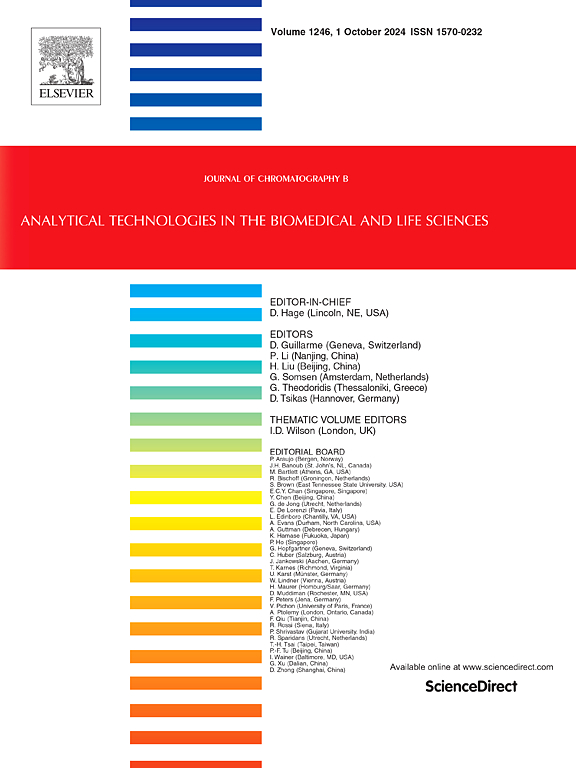Application of preparative high-speed countercurrent chromatography for isolation of a bicyclo-[3.2.1]-octanoid neolignan from Piper multinodum C. DC. and determination of its absolute stereochemistry
IF 2.8
3区 医学
Q2 BIOCHEMICAL RESEARCH METHODS
引用次数: 0
Abstract
This study aimed to propose a straightforward approach for isolating a novel neolignan compound using high-speed countercurrent chromatography (HSCCC) in combination with spectrometric techniques. The bicycleneolignan compound was detected in the dichloromethane partition obtained from methanolic leaf extract of Piper multinodum. After evaluating several two-phase solvent systems, the n-hexane/ethyl acetate/methanol/water in ratio 3:1:1:1 (v/v/v/v) demonstrated the highest efficiency for HSCCC separation of the target compound, as evidenced by the optimal distribution coefficient KD value of 1.55, using the tail-to-head elution mode, yielding 87.0 mg in 96.7 %. Its relative structure and absolute stereochemistry were unequivocally determined through 1D and 2D-NMR spectroscopy and HRMS data, complemented by NMR quantum-mechanical calculations, and application of the DP4+ method, as well as electronic circular dichroism data. Our findings confirmed the identification of the new compound multinodine -(7R,8S,1′R,3′R) (E)7-(benzo[3,4]-dioxol-1-yl)-3′,6′-dimethoxy-8-methyl-1′-(prop-7′-en-7′-yl) bicyclo-[3.2.1]-oct-5′-en-4′-one).
制备高速逆流色谱法分离胡椒中双环[3.2.1]-辛烷类新木质素。以及绝对立体化学的测定
本研究旨在建立一种利用高速逆流色谱法(HSCCC)结合光谱技术分离新型新木质素化合物的简便方法。从胡椒叶甲醇提取物中提取二氯甲烷组分,检测出双环木脂素化合物。通过对几种两相溶剂体系的评价,正己烷/乙酸乙酯/甲醇/水的比例为3:1:1:1 (v/v/v/v /v)的溶剂体系对HSCCC的分离效率最高,其最佳分配系数KD值为1.55,采用尾头洗脱模式,收率为87.0 mg,回收率为96.7%。通过1D和2d核磁共振波谱和HRMS数据,辅以核磁共振量子力学计算、DP4+方法的应用以及电子圆二色性数据,明确了其相对结构和绝对立体化学性质。我们的研究结果证实了新化合物多联机-(7R,8S, 1'R,3 ' r) (E)7-(苯并[3,4]-二元醇-1-基)-3 ',6 ' -二甲氧基-8-甲基-1 ' -(pro7 ' -en-7 ' -基)双环-[3.2.1]-oct-5 ' -en-4 ' -one)的鉴定。
本文章由计算机程序翻译,如有差异,请以英文原文为准。
求助全文
约1分钟内获得全文
求助全文
来源期刊

Journal of Chromatography B
医学-分析化学
CiteScore
5.60
自引率
3.30%
发文量
306
审稿时长
44 days
期刊介绍:
The Journal of Chromatography B publishes papers on developments in separation science relevant to biology and biomedical research including both fundamental advances and applications. Analytical techniques which may be considered include the various facets of chromatography, electrophoresis and related methods, affinity and immunoaffinity-based methodologies, hyphenated and other multi-dimensional techniques, and microanalytical approaches. The journal also considers articles reporting developments in sample preparation, detection techniques including mass spectrometry, and data handling and analysis.
Developments related to preparative separations for the isolation and purification of components of biological systems may be published, including chromatographic and electrophoretic methods, affinity separations, field flow fractionation and other preparative approaches.
Applications to the analysis of biological systems and samples will be considered when the analytical science contains a significant element of novelty, e.g. a new approach to the separation of a compound, novel combination of analytical techniques, or significantly improved analytical performance.
 求助内容:
求助内容: 应助结果提醒方式:
应助结果提醒方式:


